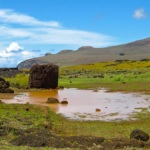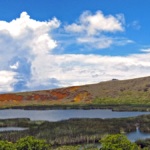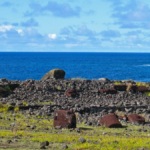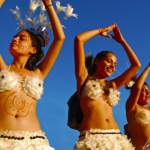Like the island described in Jules Verne’s, “The Mysterious Island”, Rapa Nui or Easter Island, lost in the middle of the Pacific Ocean, holds many archaeological and cultural treasures. Indeed, Easter Island could have been an integral part of Verne’s series “Extraordinary Voyages”… The Moaïs of Easter Island, these sculptures from another world and another time with serious eyes turning their backs on the immensity of the ocean, leave no one indifferent. Weighing several tons each, these giant heads with square jaws and long noses and look blindly ahead. They vary in shape and are between 4 and 30 feet high. The older statutes are smaller, with round heads and eyes. One Moaï, nicknamed “Tukutut,” is archaeologically very interesting. It is totally different from all the others on the island. Only about 9 feet high, the Tukututi Moaï is in a kneeling position with its hand on its lap. It is a first-generation Moaï close in style to the Marquesan Tiki. The more recent Moaï are elongated figures with carefully carved fingers, nostrils, and long ears. The largest Moaï of all is Ahu Te Pito Kura located on Hanga Hoonu Bay (also known as the Bay of La Perouse) about 1 mile southeast of Ovahe Beach. It is about 40 feet high, including its Pukao, the hat-like structure on top of the statue, and weighs over 80 tons. A few feet from “Ahu” there is a large round stone about 3 feet in diameter. It was probably used for celebrations. It is said that the god “Make-Make” (not to be confused with Makémaké the dwarf planet of the solar system), creator of the universe, who put this stone in place. Its name, “Te Pito o te Henua,” means “navel of the world“… Walking among these stone giants, we cannot help but think back to the words of the French novelist Pierre Loti who landed on January 3, 1872, on Easter Island with a frigate of the French Navy. He wrote, “C’est un pays à moitié fantastique, une terre de rêve. Les statues, il y en a de deux sortes. D’abord celles qui sont renversées et brisées et puis les autres, effrayantes, d’une époque et d’un visage différents, qui se tiennent encore debout, là-bas, sur l’autre versant de l’île, au fond d’une solitude où plus personne ne va.” (The country is half-fantastic, a land of dreams. There are two kinds of statutes. First, those that have fallen down and broken and then the others, scary monuments from a different time that are still standing. These latter are on the far side of the island in a pit of solitude where no one goes.)

The Ahu Kote Riku
A kind of magic comes from these giant stones. Some look like sentinels, others like rugby players preparing for a scrum, and yet others seem to shake their heads skeptically. Finally, some lie flat on the wet ground, knocked out like a boxer… At Ahu Tahai there is a set of three Ahus: Vai Uri, Tahai, and Kote Riku. Kote Riku, located to the north of the other two, is a lonely Moaï about 16 feet tall. It is the only one of the three to have been restored and wears a “Pukao” carved in red scoria from the Puno Pau volcano. A Pukao is a kind of hat or chignon. Other statues that have preserved their pukao are those of Ahu Nau Nau and one of the Moaï at Ahu Tongariki. This latter is the only Moaï on the island that has eyes made of white coral with black pupils. For a long time scientists have wondered how these statues weighing nearly 50 tons could have been transported ? On the eastern side of the island rises Rano Raraku. The quarry for the Moaï is on the slopes of this volcano. Blocks of stone were cut on the southern slope near a freshwater lagoon. But how were the Moaï taken to their final destination several miles away ? We still don’t know. The answer may lie in the oral tradition of Rapa Nui. Many natives say that the Moaï walked thanks to the “Mana” the strength of the spirits… Ok, even if I like the folklore of « Manamana », we are still not in a sketch of the Muppet Show ! So if they did not walk, how did they move ? They were probably rolled on logs while lying on their side. Until recently, scientists thought that the Moaï were entirely carved before being transported, which would represent a remarkable achievement since their raw material was a type of rock known as lapilli tuff, a porous rock formed by the accumulation of volcanic ash. Because this rock is very soft, the slightest shock could have damaged them! In fact, the Rapa Nui probably transported partially finished statues, lighter than raw stone but still homogeneous enough and without detail to be easily transported. It cannot be that the statues were perfectly finished and transported across the island like trophies… And here is the solution to one of the great mysteries of archeology !

Crater of Rano Raraku
One mystery hides another ! If today some statues are standing, it is because archaeologists have restored them and put them back in their upright position. When Pierre Loti explored the island in the 19th century, all the Moaï near villages were laying on the ground… Why were they pushed over ? According to official Chilean history, this is part of the theory of collapse, an ecological suicide theory. Everything began in the 17th century when the island experienced population growth. All the trees were probably cut. This severe deforestation led to soil erosion, and agriculture collapsed causing a terrible famine. Statues with exposed ribs and emaciated bodies, the “Moai Kavakava” meaning Moaï with ribs are evidence for this theory… They are representations of starving ancestors or demons. Almost dead of starvation, the Rapa Nui apparently engaged in a savage war using weapons of war that archaeologists find everywhere on the island. Warring clans may have knocked over the Moaï belonging to enemy villages. And in the quarry on the slopes of the volcano, the workers would have abandoned partially complete Moaï… But let’s try to separate the true from the false in this myth of the collapse… By carefully examining these Moaï laying on the ground, one realizes that they are intact, in one piece. However, a Moaï made of volcano tuff falling from a height of about ten feet at least break its nose! It is impossible to imagine for a single second that these statues were thrown violently to the ground. On the contrary, they were laid on the ground with delicacy and respect. But then, if not war, what drove the Rapa Nui to lay down their Moai ?

Moaï strangely positioned on the slope of the volcano Rano Raraku
The volcano Rano Raraku’s slopes answer some questions. Hundreds of Moaï are concentrated in this “sculpture workshop.” It is a fascinating place where peace and silence produce a strange feeling of abandonment… Until the 18th century, the quarry was bursting with activity. The island was then in its golden age, but then, according to the theory of collapse, the workers suddenly threw down their tools and abandoned the quarry… never to return… Hundresds of incomplete statues remained behind. When Thor Heyerdahl arrived on the island in 1957, the ground was littered with thousands of “tokus,” the stone axes used by sculptors. But is this story true? At the beginning of the 20th century, archeological excavations revealed that some Moaï were strangely positioned on the slope of the volcano in pits that were dug beforehand. We know today that these Moai have not only heads, but also half-buried bodies. Some are buried up to the shoulder, others up to the nose. The feet of the statues are secured in a base. The intention was apparently to leave them in place, upright and not to move them elsewhere. This discovery, of course, has greatly intrigued scientists… The most likely hypothesis is that the quarry was carefully shut down in the 18th century. It seems that the Rapa Nui forbade further exploitation of the quarry. If you look closely at the quarry, there are gigantic immovable Moaï, such as the 69 foot tall Moaï Te Tokanka, weighting 200 tons, blocking access to the quarry. In addition to the unfinished statues in the quarry, there are several Moaï on the slope. They were at first mistaken for abandoned statues. Like sentinels standing with their backs to the mountain they make it impossible to move new statues out of the quarry. But one answer leads to many other questions… Why did the Rapa Nui break off work and post Moaï as guards ?

Crater of Rano Kau
Besides the gigantic Moaï statues, Easter Island offers many surprises and archaeological vestiges. Although the island is only 63.2 square miles in size, it contains over five miles of underground galleries, one of the most extensive systems of volcanic caves in the world. Some caves have magnificent rock art. Petroglyphs date back to the 18th century, precisely when the inhabitants stopped making Moaï. The petroglyphs represent the god who Polynesians believe created man, “Make-Make”, and Tangata Manu, a half-bird half-man figure considered to be his representative on earth. The Ana Kai Tangata contains vestiges of the worship of the bird-man. The cave, or Ana in Rapanui language, is about 32 feet wide, 16 feet high and 50 feet deep with its entrance on the seafront overlooking the ocean. The spectacular ancient rock art in white, red and black portrays Manutara, seagull, the icon of the cult of Tangata Manu. Unfortunately, the porous nature of the rock and deterioration from humidity have caused some damage and the colors have lost their original intensity… Is it a mysterious happy coincidence? Hum, hum, some coincidences have a meaning… They are part of the mysterious phenomenon that the Swiss psychiatrist Carl Gustav Jung calls “synchronicities”, a term that, although used in everyday language, does not appear in any dictionary ! It seems that towards the end of 18th century that the cult of the Moaï was replaced by the cult of “Make Make”. This spiritual revolution completely transformed the Rapa Nui’s political system. Power that was previously fragmented between the various clan leaders became concentrated in the hands of a single man, considered to be the representative of “Make Make” on earth, the bird-man. Thanks to reports from a 19th-century missionary, scientists know that the bird-man was designated at an annual race, similar to an IronMan race (but without the costume of Tony Stark) !

The Motu Nui about 1 mile offshore
The competition to be designated bird-man was held in the village of Orongo, in the southwestern part of the island on the western slope of the magnificent Rano Kau volcano (4,900 feet wide and 1,063 feet above sea level).) The volcano has a crater lake, which is one of the island’s natural bodies of fresh water. From the Orongo archaeological site, one can enjoy a breathtaking view of the islets Motu Kau Kau (the peak), Motu Iti (smallest island) and Motu Nui (largest island.) The village includes some fifty sod-covered houses with very particular architecture. They were built windowless using thin slabs of stacked stones with extremely low and narrow entrance doors. People had to crawl in. Orongo was the center of the bird-man cult. The families gathered in the village to encourage the athlete who had been chosen to represent their clan to bring the first Manutara (sooty tern, Onychoprion fuscatus in the family of Laridae) egg back undamaged from the nearby islet of Motu Nui. This “Tangata Manupour” ceremony is an annual race for prestige and against vertigo… Imagine the “Hopu,” warrior-athletes, racing through this extreme triathlon: climbing down an 820-feet cliff and swimming against treacherous currents to Motu Nui about 1 mile offshore. A dangerous race, if athletes did not fell to their death from the cliff, they risked their lives in dangerous waters full of sharks… « ta ta ta ta tatatata tatatata…” attracted by the blood of the wounds from sharp rocks on the cliff. The lucky winner won the honor for the leader of his clan and became the bird-man for the year. The bird-man, as privileged interlocutor between the gods and the men, had almost absolute power over the island. He was feared, respected, and admired by the other clans of the island… But the fact that there was an annual race limited his power to one year. Without this limit, we could very easily have a tyrant, no ?

The triathlon “Tau’a Rapa Nui”, running
The Rapa Nui civilization nearly disappeared, a victim of barbaric human behavior (massacres, slavery, etc.) and diseases transmitted by Europeans (especially smallpox and leprosy). Only 110 Rapa Nui remained of the 3500 to 4000 present when slavers arrived in 1862… But today, half of the 5000 inhabitants of Easter Island are the descendants of these 110 survivors ! Aware of the fragility of their cultural heritage, the Rapa Nui guard their legacy with fervor. Their pascuane language, banned until the 1970s, is now taught in schools: children up to the age of eight have almost all their classes in Rapa Nui! Today, 77% of children speak Rapa Nui, compared to 10% just fifteen years ago. The cultural event of the year, the Tapati Rapa Nui festival, has, since February 1975, selected the most beautiful woman and perpetuates ancestral traditions. It is above all a means of transmitting Rapa Nui culture while having fun. During the festival, clans compete in diverse and sometimes spectacular events. The candidate of the winning clan is elected queen of the island and will represent the cultural traditions for the year… Well, they also have a Madame de Fontenay with a beautiful hat ? For two weeks, traditional sports and cultural competitions are judged by a jury. On the program are folk dance and costume competitions, traditional songs recounting ancestral legends (“Riu,”), sculptures and engravings on the theme of Moai. It is quite amazing to see the number of people who sculpt, paint, draw, sing and dance with ease! The contest called “Titingi Mahute” consists of working the mahute (a plant introduced by the first inhabitants of the island) with which the costumes are made. In this contest the mahute is first worked with small wooden sticks and then stretched over a round stone (the “Maea pore”). Women also practice “kai-kai”, the ancient art of retelling legends (“patautau”), miming the facts with a rope stretched between their fingers. On the physical side, the triathlon “Tau’a Rapa Nui” consists of three events that take place in the crater of the volcano Rano Raraku. It consists of first crossing of the lagoon on a boat of dried reeds (“Vaka Ama” test), then running around the lake carrying a cluster of bananas under each arm (about 100 pounds), and finally climbing to the top of the crater slopes, a second crossing of the lake where athletes swim with a reed float (Pora). The most dangerous competition, the “Haka Pei,” consists of sliding down the side of the volcano Maunga pu’i (at 45 ° the steepest on the island) as fast as possible on a sled of interwoven banana trunks… Competitors reach speeds of 50 mph! Competitors are nearly naked and holding on to a banana trunk can play tricks… Aie, aie, aie !
« Iorana Tangata Rongo Rongo »




























WOW! I really enjoyed reading this post and learning more about this Island. Love the photos you included.
It was really amazing to visit the birthplace of the Moais, one of Earth’s yet-to-be-revealed mysteries ! Visiting this out of the way destination and seeing these statues has been a life long dream of mine 😉
This is incredible! I haven’t ever heard of Easter Island but I’d love to go there! All the stonework is awesome and I loved looking through your photos! Thanks so much for sharing. Pinning to my travel board and adding it to my bucket list!
Thank you 🙂 Was quite emotional standing in front of the Moaï for the first time and really realizing where on earth I was standing. A dream to be there and see these Moaï only feet away !
Your post reminds how beautiful this world is. Absolutely loved the photos and reading about Easter island.
I fully agree with you: the world is full of diverse destinations that are amazing to discover ! Easter Island is worth the trip, it is a unique location with its own unique culture, the Moai statues are truly iconic and give us an insight into the workings and philosophy of a past civilisation.
what an exotic destination! I have always wanted to travel to a place like that, it looks out of this world! Thank you for taking us there with your lovely images and words!
Ah, ah who wouldn’t want to visit this mysterious tiny island in the middle of nowhere ?
What an INCREDIBLE place to visit! I love seeing photos of the people who have adapted to different landscapes, it really sets the stage and tells the story. Beautiful images!
It is a truly magical island and is a destination like no other ! It’s really amazing to take a stroll on Easter Island and take in the beauty and grandeur of the Moaï 🙂
What an amazing place. I love the history behind the island. I found it quite interesting to read.
Thank you ! When it comes to ancient mysteries, there are few as fascinating as the one surrounding Easter Island 🙂
Such a gorgeous place to discover! I’ve heard of the Easter Island but honestly didn’t really know much about it beyond its name. It sounds like a magical place to visit. Oh and some of its iconic spots have been featured in popular culture, so in a way it is familiar to us all.
Easter Island captures the imaginations of many travellers with its mysterious and enigmatic past 😉 The history and culture is fascinating and still a very prominent facet on the island !
Such beautiful images of the island. I bet it looks even better in person.
Thank you 🙂 With it’s unbelievably statues, Easter island should definitely be on your bucket list. If it’s not, it soon will be…
Oh my days, that is definitely being added to my must- visit list. Thanks so much for sharing your thoughts about it. Easter Island here I come!
Easter Island is the world’s most remote island ! Everyone should visit Easter Island at least once In their lifetime 🙂
Easter island is so fascinating, I’ve always wanted to visit so hoping I get the chance to someday
Of all the places you can visit in Chile, Easter Island is probably one that lends itself more than any other to myths and legends !
I have been here before and there truly is no other place on the planet like it. It has almost a haunting feeling to it.
I fully agree with you 🙂 It’s amazing to visit the birthplace of the Moais, one of Earth’s yet-to-be-revealed mysteries !
Wow it is indeed mysterious island! And it is gorgeous and unique. I could imagine the unique culture and experiences you have there. Treasure it!
The history and culture is fascinating and still a very prominent facet on the island. Of all the places you can visit in Chile, Easter Island is probably one that lends itself more than any other to myths and legends 😉